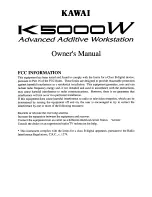
Cell Connections – Fuses in the Cell Cable
49
Access to the fuses requires removal of two screws located on opposite sides of the hood covering the
D-connector end of the Counter/Working cable. A drawing of the D-connector end of a cable with the hood
opened is in Figure 6-2. The small rectangular fuses snap into fuse-holders labeled
Work
and
Cntr
. To remove
the fuse, either grip it with small pliers and gently lift the fuse out of the fuse-holder or pry the fuse out of the
fuse-holder using a small screwdriver or knife blade.
After a fuse has been removed, you can check it using an ohmmeter, such as that found on modern digital
voltmeters. A blown (open) fuse should always have a resistance of greater than 100 Ω. The resistance of a
good fuse is very small.
Don’t forget the jackscrews when you reassemble the hood.
Figure 6-2
Drawing of Fuse-holder in the D-Connector Hood
Four replacement fuses should accompany every Counter/Working cell cable shipped by Gamry Instruments.
The Gamry Part Number for the small rectangular fuses is 630-00021. If you need to buy replacement fuses
locally, we currently only recommend Very Fast Acting, 3.15 A, Nano Fuses from the Littelfuse Corporation.
The Littelfuse Part Number is 04513.15MRL. Fuses with similar ratings from other manufacturers have not been
tested, so we cannot recommend their use.
Caution:
Always replace the fuses in a Reference 3000 cable with the recommended
fuse. Use of an improper fuse, especially a fuse with a higher current-rating, could cause instrument failure
if a battery cell is improperly connected. Use of a non-approved fuse will void Gamry’s factory warranty.
Always turn off the Reference 3000 and disconnect both ends of the Counter/Working cable
before checking or replacing the fuses in the cable.
















































